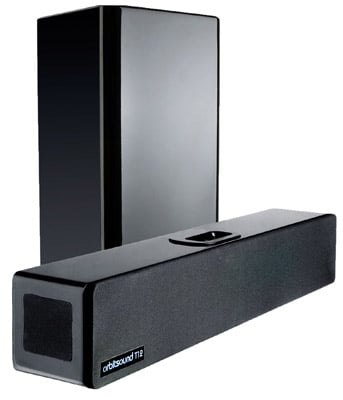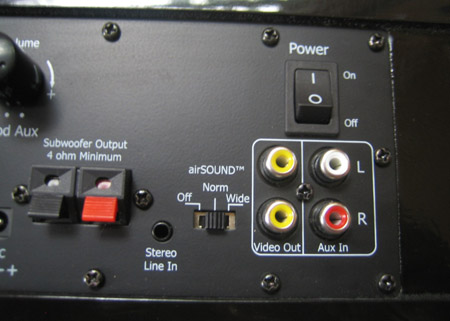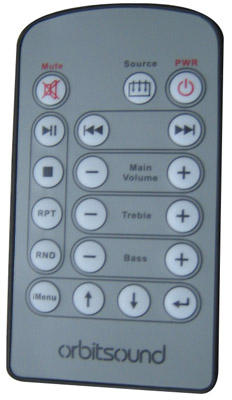Original URL: https://www.theregister.com/2008/08/05/review_orbitsound_t12_soundbar/
Orbitsound T12 soundbar
Stereo sound from one speaker? That's just crazy talk
Posted in Personal Tech, 5th August 2008 09:37 GMT
Review The T12 stereo ‘soundbar’ represents a totally unique take on the category; it goes back to the dawn of stereo technology itself to deliver a genuine revolution in sound reproduction.
Using technology developed by its sister technology Airsound, the Orbitsound T12 is designed to give a boost to TV audio as well as act as a music system for an iPod (via its own dock) or other peripherals by way of a line-in jack and stereo inputs. Whilst the unit is not the highest specified you will ever come across, what it does in terms of the sound is extremely impressive.

T12: can reproduce wide stereo fields from a single speaker
The unit’s ace in the hole is that it can reproduce wide stereo fields from a single speaker. "Impossible!" we hear you cry. By definition stereo is two speakers. Actually, that's not necessarily true, but we have to go back in time to the beginning of stereo reproduction for an explanation.
Airsound explains its technique is based on the theories of inventor Alan Blumlein, who in 1931 described a method of recording and reproducing 'stereophonic' sound. His theories centered around the notion that (as we have two ears) the ability to recognise where a sound is coming from is to do with how the sound reaches our ears - if one side is louder than the other, then the sound is located on the loud side.
Alan thought that it might be possible to record and reproduce 'spatial' sound, using a principle called 'sum and difference' or 'middle and side' (M/S). This involved using an omni-directional microphone to record the main signal information, and a figure-8 response (or 'dipole') microphone set across the 'field of sound' to record the spatial information.
By adding and subtracting the 'omni' or 'sum' signal with the figure-8 or 'difference' signal, it should be possible to arrive at a conventional 'left' and 'right' audio signal. Airsound says that despite some flaws in the theory, the M/S system can be used as the basis of reproducing sounds with space with the M signal representing the majority of what the listener hears and the S signal delivering the spatial information.
The T12 uses main drivers mounted on the front of the enclosure (the M signal for the majority of the sound) and S drivers on the side (the S signal for the spatial information).

The unit is not overly blessed with connection options
The system also employs a phenomenon known as ‘the surface effect’. The company says that the effect is best described as imagining yourself standing by a lake on a still day. You will be able to hear sounds a long way off right on the other side of the lake. This is because when sound is reproduced near a flat surface, it travels great distances at high levels of volume if the linear dimensions of that surface are greater than those of the main frequencies with the sound.
All fine in theory, but does it actually work? Well, it does, and we really enjoyed the type of sound the unit produced. There are several areas to wich the unit is designed to bring enhanced sound - firstly, there's TV playback. Of course this is going to depend on your TV - we tried it on a brand new 40in Samsung, which has moderately good sound for its class, and the T12 did much better than the TV's own speaker array.
The field created feels enveloping, while vocals remained in good clarity. Bass extension was particularly good, down to the very meaty sub that comes with the unit. The unit is not overly blessed with connection options - just an iPod dock on top, left/right audio inputs on the back and a line-in input. However, we tried putting the TV sound through the line-in jack via the TV’s headphone socket (as suggested by the manufacturer to increase connection options) and the performance was still very good. You can of course attach the speaker to audio-outs from your TV - this produces good results, as does attaching the audio outs on your Sky box or similar.
If you don’t have an iPod then of course the product will be less appealing. There is basic control of the Apple product via the unit’s own remote, but there is the line-in option for those with other MP3 products. The performance we experienced with TV sound was good, but stereo music production is where the little devil really hits its stride. A bit of Duffy followed by British blues/rock riff kings Thunder proved the system versatile enough to cope with different frequency ranges. But what really takes you by surprise is the genuinely stereo sound that you get, via iPod or CD player.
The sound really fills the space and we found ourselves peering at the box trying to work out where the sound was coming from. The trick seems to be that, unlike many conventional designs, this technique works with its environment, using the room’s surfaces to expand the sound.

The unit also come swith it's own easy-to-use remote
Coupled to the spatial techniques employed by the speaker, it really does create a very pleasant and listenable stereo field. Some problems can occur at low bandwidths via MP3 playback if the recording is a bit poor. On the rear of the unit there is a switch that allows you to control the amount of stereo dispersion applied to the signal, which irons out most problems.
For a bit of fun, we unplugged the speakers from a BOSE 3.2.1 GS system and compared how the T12 compared when the DVD sound was fed through the T12 rather than the BOSE speakers. It was not as good, but it was close. It's not the loudest speaker you will find, but it made much of the sacrifice scene from Mel Gibson’s Apocalypto, with every sickening thud and squelch delivered over an engaging sound field with real accuracy.
Verdict
For the money, this is well worth a look. The speaker cables provided (between sub and main speaker) are not the best, so perhaps upgrade these. A few more connections would not go amiss, if only to be able to enjoy the product’s undoubted sound qualities from more sources. The sound created is a real ear-opener and at the same time does not feel gimmicky and could easily become your main living room sound reproduction unit.